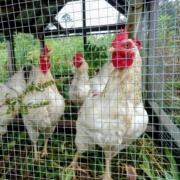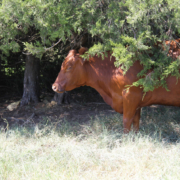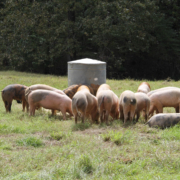Heritage Chickens: A Rare Breed in Modern Coops
 Print This Post
Print This Post
By Danielle Crocker, NCAT Agriculture Specialist
There was once a time when the American backyard was a bustling chicken metropolis. Families raised heritage chicken breeds—the OGs of the poultry world. Breeds such as Dominque, Brahma, Delaware, Jersey Giant, Buckeye, Rhode Island White, and New Hampshire chickens were common dual-purpose yard birds. Much like heirloom vegetable seeds preserve distinct colors, shapes, flavors, and nostalgia, heritage livestock mirrors the same paradigm of genetic preservation. Some heritage breeds are so rare they are at risk of extinction.
What defines a heritage chicken, you ask?
- They are standard breeds recognized by the American Poultry Association.
- They mate naturally.
- They have a long productive lifespan.
- They are slow-growing, reaching appropriate market weight for the breed in no less than 16 weeks.
These animals were bred over time to develop traits suited to specific local environments. Heritage fowl provided eggs, meat, and entertainment. But alas, the winds of change blew through the coop and today, many heritage breeds face an existential egg-sistential crisis. So why are these once-beloved chickens no longer the talk of the town?
The Rise of Industrialization
Between 1940 and 1960, chickens went from quaint backyard residents to industrialized food machines. Hybrid breeds, engineered for rapid growth and efficient meat production, took center stage. Hybrid birds can sprint from chick to table in just eight weeks! The demand for quick, uniform results led to the decline of the slower-growing heritage breeds. Heritage chickens take their time. They’re not in a rush to grow up, lay eggs, or become the next big thing.
Egg Color Obsession
Heritage breeds don’t play by the egg-color rules in this modern world. They lay eggs in hues that defy convention—blue, green, pink, chocolate brown. In the eyes of a small market vendor, this rainbow assortment is eye-catching for your table!
But the egg aisle at the supermarket prefers uniformity. White and brown eggs, neatly stacked with no surprises. While commercial breeds pump out predictable egg cartons in high volume, heritage fowl quickly fade into obscurity.
Genetic Diversity Crisis
Heritage breeds are the genetic time capsules of chicken history. Their DNA carries stories of settlers, pioneers, and homesteaders. As industrial breeds take over, genetic diversity dwindles. The Livestock Conservancy sounds the alarm: more than three dozen heritage breeds are on the endangered list. By choosing to raise heritage breeds you are directly contributing to their survival.
I’ve raised my fair share of heritage fowl, perhaps the more “common” ones, as accessibility is the largest obstacle. Here’s the list of birds I’ve had the pleasure of raising:
Dominique chickens are recognized as America’s oldest breed. They are prized for their dual-purpose practicalities and distinctive plumage. They are hardy in most climates and are excellent foragers. Dominiques produce around 250 light brown eggs annually. They are a fine choice for the backyard flock.
Australorps originated from Australia in the late 1800s, they are renowned for their dual-purpose capabilities. These glossy, beetle-green iridescent birds can lay up to 250 large, brown eggs annually. Australorps are docile and family friendly.
Welsummer chickens originate from the Netherlands. They are adorned with black speckles on chestnut feathers. These birds lay a large terracotta-colored egg with dark speckles. These eggs are a farmer’s market conversation piece. Welsummer chickens are truly a beautiful addition to the small-scale farm.
Rhode Island Red chickens (RIR), originate from the United States. They are fine meat birds but are exceptional egg-layers, having the ability to lay 300 light brown eggs annually. RIR thrive in a variety of climates, making them a reliable choice for backyard flocks.
Wyandotte chickens originate from the United States and are cherished for their stunning appearances. These birds come in a variety of laced patterns and colors. Their feather fashion alone makes these birds sought after. They’re decent dual-purpose chickens, laying about 150 brown eggs annually.
Delaware chickens originate from the United States. They are friendly and hardy to the elements. They lay about 200 jumbo pinkish-brown eggs annually and were the quintessential meat and egg producers. I found them to be exceptional dual-purpose birds. Of all the chickens I’ve raised, these are still my favorite.
According to The Livestock Conservancy, heritage breeds are being raised on more than 4,000 farms, ranches, and backyards across America. Still, new breeders must be recruited to protect and expand rare livestock and poultry populations. As I mentioned, accessibility is the biggest hurdle when it comes to raising heritage breeds. Some of the more common heritage breeds can be found at your local livestock store. If they don’t have what you are looking for, just ask. Breeds that are more rare and hard to find will take more investigation.
You can find the list of heritage breeds here. If you are currently raising or interested in raising heritage breeds, check out microgrants and listings offered by The Livestock Conservancy.
Related ATTRA Resources:
Pastured Poultry Nutrition and Forages
Organic Poultry Production: Providing Adequate Methionine
Pastured Poultry Nutrition and Forages
Small-Scale Livestock Production
Other Resources:
Heritage Breed Marketplace, The Livestock Conservancy
Microgrant Program, The Livestock Conservancy
Conservation Priority List, The Livestock Conservancy
This blog is produced by the National Center for Appropriate Technology through the ATTRA Sustainable Agriculture program, under a cooperative agreement with USDA Rural Development. ATTRA.NCAT.ORG.









 NCAT
NCAT
